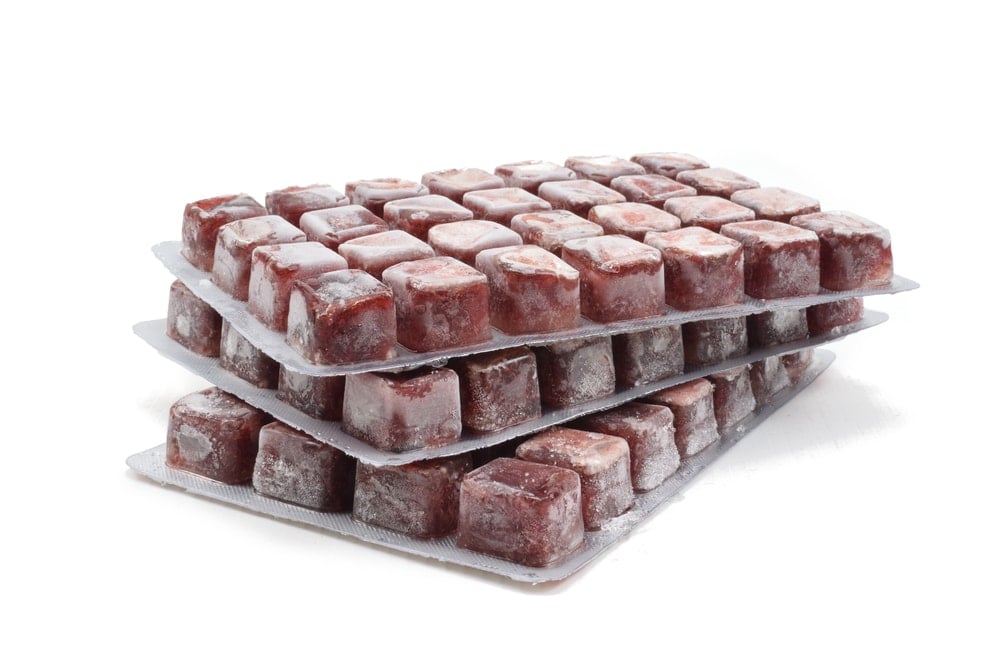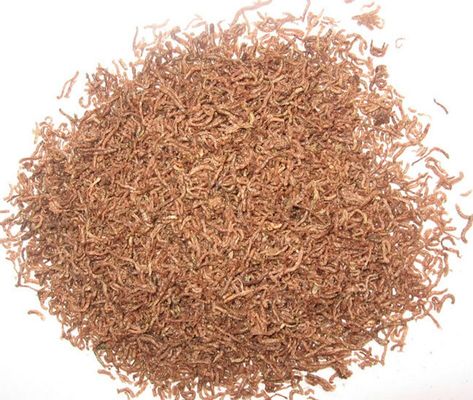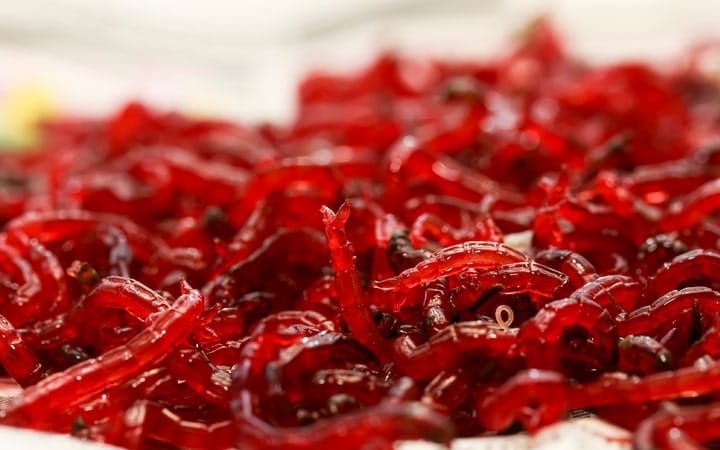Bloodworms are not unfamiliar for everyone in the aquarium scene. In fact, it is one of the most popular nutrient sources (or snacks) for many types of fish.
Besides being well-known as bait, bloodworms are also famous and highly demanded as fish food. You can see them being sold everywhere across the globe and can be used to feed fresh or saltwater fish.
Despite people calling them worms, they are actually larvae. But they do look like worms, to be fair. The intense red coloration that they have is also a factor in how they got their name.
In this guide, we will tell you all the things that you need to know about bloodworms before you give them to your fish. We will also answer some questions you might already have. Let’s jump right in!
Table of Contents
About Bloodworms
There are two most famous types of bloodworms in the aquarium trade. Chironomidae, the red one, inhabits moving freshwater like rivers, streams, or lakes. Another one is the pink one from the genus Glycera and lives in shallow marine waters.
First, the small red larvae from the non-biting midge flies (Chironomidae). This type of bloodworm is recognizable from its sharp red color. The color they display is from the iron-porphyrin protein in their blood and skin tissues.
Normally, this kind of bloodworm won’t exceed the size of one inch. They can live and thrive in polluted waters with low oxygen levels due to the high hemoglobin content they have in their bodies.
The second type of bloodworm is from the genus Glycera, which is a group of bristle worms. Unlike the Chironomidae, this type has a blushy pink color and can reach the size of 14 inches. Besides, they also have venomous bites. So if you’re getting them from a store, make sure to get the venom removed.
In addition to their appearance, they have four little antennae on their heads. You can also see a few small projections on the body, which are called parapodia. The worms use parapodia to sense and for locomotion function.
Naturally, the bloodworms are carnivores. They extend a big proboscis with four hollow jaws to eat. Their bite is strong enough to kill their prey and might cause pain to people. Be careful if you touch them while they are still alive.
These tiny creatures are suitable to feed not only fish but also several other aquatic species. That includes crabs, frogs, salamanders, snails, shrimp, and turtles. Once again, make sure you don’t feed them the venomous worms.
Fun Facts
- The population of bloodworms has been decreasing worldwide. In the 1990s, the average tide would carry around 4000 worms whilst it only carries around 550 worms now
- Bloodworms can use their intestines to breathe
- Although they spend most their lives in water, bloodworms are not good swimmers
3 Types of Bloodworms as Fish Food
Bloodworms are food for the fish. And just like other fish food out there, bloodworms come in a variety of forms. The most common forms you can find are frozen, freeze-dried, and live bloodworms.
Frozen
The Frozen one is the most popular form of bloodworms among aquarists. It is mainly because the frozen one is more convenient to store, and you can keep it up to 6 months from the date of packaging in the freezer.
Another reason is, it comes in blocks or thin sheets form. Frozen bloodworms also reduce the possibility of diseases, infections, or parasites transferred into your tank.

However, there are several downsides to this frozen form. First, you will not see your fish hunt the worms as the food is not alive. There won’t be many activities during feeding time.
Second, you need to thaw the frozen food first before giving it to your aquatic pets. Fish are not used to eating cold food. Chances are they won’t even touch the frozen bloodworms.
There are some steps you can do to unfreeze the bloodworms. First, place a cube of frozen worms in a small container filled with a bit of tank water.
Once the worms are thawed, strain it to remove the juice and water from the defrosted bloodworms. You can then put them in the tank as your fish’s food.
When giving them food, make sure that you don’t overfeed them. How do you know whether you overfeed your fish or not? You can observe your fish when they eat during feeding time to see if there’s any leftover.
If you see some food still left uneaten after two minutes, it’s a sign that you give them too much food. In that case, remove the leftover food immediately from the water.
To feed your fish, you can do either mass feeding by adding the bloodworms over the length of the tank or feed the fish directly. If you do the latter, you will need to use tongs or pipettes.
Freeze-dried
This is another convenient form of bloodworms. Freeze-dried bloodworms normally come in small plastic tubs. It is, however, the least nutritious one. Making it not so interesting for many aquarists.
But it doesn’t necessarily mean that the freeze-dried form contains no nutrition at all! It still provides some essential nutrients to your fish, just not as much as other types of bloodworms.

In stores, freeze-dried bloodworms are available in Grade A and Grade B. It is recommended to purchase the Grade A one, although it’s slightly more pricey. That’s because Grade B has a lower quality and might contain non-bloodworm elements.
Since the food is dried, you need to soak it in clean water for around 5 minutes before feeding it to your fish. Even so, the freeze-dried bloodworms will still tend to float in water. So if you aim to feed it to your bottom dwellers, you will need to soak it for approximately 10 minutes.
Just for additional information, make sure that you soak the freeze-dried bloodworms long enough before placing them in the tank. That’s because there is a concern that the food might expand in the fish’s belly after it gets eaten. Such cases can cause serious health issues later.
Live Bloodworms
Live bloodworms are not the most convenient and are rather hard to find. However, they are the most nutritious ones.
They can’t be easily stored like the frozen and freeze-dried forms. The larvae life cycle is quite short, around 10-12 days. Therefore, it’s advisable to feed the live bloodworms to your fish within 2-3 days after buying them.

Live bloodworms usually come in a plastic container when you buy them. Before giving them to your fish, you need to rinse them thoroughly since they might carry dirt on their bodies. In addition, you should not add the water that the worms came with into your tank.
After cleaning the live worms, you can place them in the fridge. Make sure that the container they’re in has a lid. Also, there should be enough water to cover the bottom of the container.
Besides being the healthiest among other bloodworms forms, live worms will also trigger your fish’ hunting instinct. You can expect many activities to happen during feeding time. They are also great if you’re conditioning your fish to breed.
While there are many benefits that live worms bring, there’s also a drawback. There’s a higher risk of them transferring diseases and infections into your aquarium. Therefore, finding your own bloodworms in the wild is not recommended.
To evade such unwanted conditions, you can get live bloodworms from reputable breeders.
More Information about Bloodworms
- Freeze dried bloodworms are easier to store but have less nutritions
- There are bloodworms in gel form which have a life span of 2 years. It also includes extra vitamins
- You can get bloodworms in small packets that you can store in a cool dry place
Do Your Fish Eat Bloodworms?
The answer is most likely to be yes. All kinds of fresh or saltwater fish that are omnivorous and carnivorous will happily accept bloodworms. It is also used as bait, and most fish eat them.
We have here a long list of fish that you can feed the bloodworms to. They include:
Bloodworms are also not limited to being fed only to fish species. Some non-fish aquatic pets that also love bloodworms are:
- Frogs
- Crabs
- Salamanders
- Eels
- Shrimps
- Snails
- Turtles
Although bloodworms contain a lot of protein and iron, you can’t use them as your fish’s daily food. Instead, you can use them as supplements or treats in addition to their diet (usually flakes or pellets).
Bloodworms lack minerals, amino acids, and vitamins that your fish need. Therefore, only giving your fish bloodworms daily will not provide them with a balanced diet.
Breeding and Growing Your Own Bloodworms
Breeding your own bloodworms definitely lowers the risk for them to contain infections and diseases. Some also think that it will save them some money and will be more convenient. However, it is apparently difficult and might feel like a job later.
To breed them, you need to see them throughout their entire life cycle. For that, you will need a place where they can develop into fully-grown flies. These flies are pretty hard to manage as they will fly around, and you need to keep them from escaping the room.
The four stages of bloodworms are egg, larva, pupa, and adult midge. The hardest part within this cycle is to make the adult midges swarm and mate in captivity.
There are still other things you need to know before breeding bloodworms. You will need a room specially designed to breed them, maybe like a greenhouse. But if you have an outdoor pond, you can encourage the flies to lay their eggs there. Then, you can collect the eggs you see in the pond.
There is also another option you may want to try. Instead of breeding them, you can raise them from eggs. First, you need to get Chironomid eggs and place them in a container filled with soil and manure. Next, add some water and put them in a cool and dark place.
Then, you can give them a little manure every week until the eggs start to hatch and become bloodworms. You can feed them to the fish by catching them with a net.
Frequently Asked Questions
Do bloodworms bite?
Bloodworms from the genus Glycera bite. Well, most of them.
Are bloodworms dangerous to humans?
They are not necessarily dangerous. But if you get bit, you might feel a sensation like getting stung by a bee or show some allergic reactions. Some of them are venomous, so it’s better to wear gloves before you have direct contact with them.
What do they eat?
They are carnivorous. In the wild, they eat food with meat substances. They also eat detritus and organic matter in muddy habitats.
What are bloodworms good for?
Bloodworms are rich in iron and protein. You can provide them to your fish as an additional supplement. They are also good to condition your fish if you’re about to breed them, especially Bettas.
Can they survive in aquariums?
Midge larvae don’t survive in aquariums as they are flies. They are land dwellers and need oxygen to breathe. Some bristle worms, however, can live in certain tanks. But it is unlikely for them to survive since there will be no food sources. Also, they only live in saltwater. Most saltwater fish are predators, so the chances for the worms to survive are relatively low.
Conclusion
If you’re wondering whether your fish eat bloodworms, there’s a high possibility for the answer to be yes. All carnivorous and omnivorous fish will gladly devour them.
But keep in mind to not feed them bloodworms too often. Overfeeding your fish with it might cause constipation. You can give your fish worms once or twice a week as tasty treats.
Do you have any experience with feeding your fish bloodworms? Let us know in the comment!






